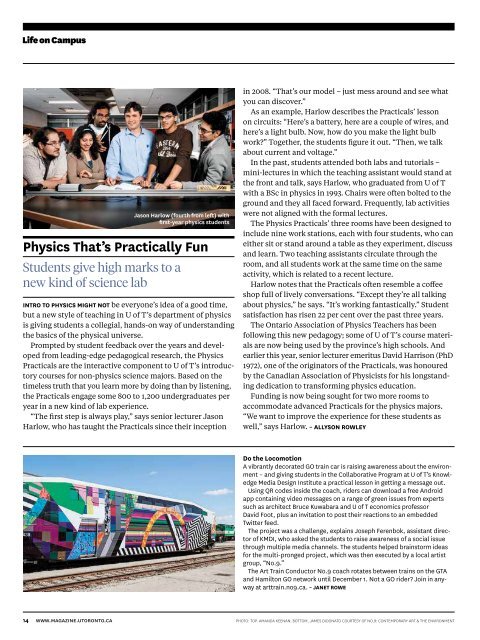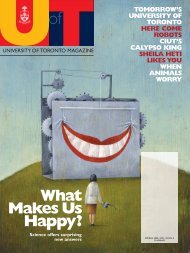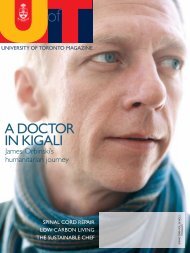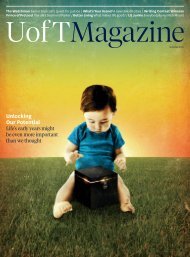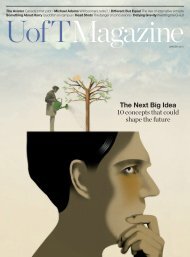8 MB - University of Toronto Magazine
8 MB - University of Toronto Magazine
8 MB - University of Toronto Magazine
- No tags were found...
You also want an ePaper? Increase the reach of your titles
YUMPU automatically turns print PDFs into web optimized ePapers that Google loves.
Life on Campus<br />
Physics That’s Practically Fun<br />
Students give high marks to a<br />
new kind <strong>of</strong> science lab<br />
Jason Harlow (fourth from left) with<br />
first-year physics students<br />
Intro to Physics might not be everyone’s idea <strong>of</strong> a good time,<br />
but a new style <strong>of</strong> teaching in U <strong>of</strong> T’s department <strong>of</strong> physics<br />
is giving students a collegial, hands-on way <strong>of</strong> understanding<br />
the basics <strong>of</strong> the physical universe.<br />
Prompted by student feedback over the years and developed<br />
from leading-edge pedagogical research, the Physics<br />
Practicals are the interactive component to U <strong>of</strong> T’s introductory<br />
courses for non-physics science majors. Based on the<br />
timeless truth that you learn more by doing than by listening,<br />
the Practicals engage some 800 to 1,200 undergraduates per<br />
year in a new kind <strong>of</strong> lab experience.<br />
“The first step is always play,” says senior lecturer Jason<br />
Harlow, who has taught the Practicals since their inception<br />
in 2008. “That’s our model – just mess around and see what<br />
you can discover.”<br />
As an example, Harlow describes the Practicals’ lesson<br />
on circuits: “Here’s a battery, here are a couple <strong>of</strong> wires, and<br />
here’s a light bulb. Now, how do you make the light bulb<br />
work” Together, the students figure it out. “Then, we talk<br />
about current and voltage.”<br />
In the past, students attended both labs and tutorials –<br />
mini-lectures in which the teaching assistant would stand at<br />
the front and talk, says Harlow, who graduated from U <strong>of</strong> T<br />
with a BSc in physics in 1993. Chairs were <strong>of</strong>ten bolted to the<br />
ground and they all faced forward. Frequently, lab activities<br />
were not aligned with the formal lectures.<br />
The Physics Practicals’ three rooms have been designed to<br />
include nine work stations, each with four students, who can<br />
either sit or stand around a table as they experiment, discuss<br />
and learn. Two teaching assistants circulate through the<br />
room, and all students work at the same time on the same<br />
activity, which is related to a recent lecture.<br />
Harlow notes that the Practicals <strong>of</strong>ten resemble a c<strong>of</strong>fee<br />
shop full <strong>of</strong> lively conversations. “Except they’re all talking<br />
about physics,” he says. “It’s working fantastically.” Student<br />
satisfaction has risen 22 per cent over the past three years.<br />
The Ontario Association <strong>of</strong> Physics Teachers has been<br />
following this new pedagogy; some <strong>of</strong> U <strong>of</strong> T’s course materials<br />
are now being used by the province’s high schools. And<br />
earlier this year, senior lecturer emeritus David Harrison (PhD<br />
1972), one <strong>of</strong> the originators <strong>of</strong> the Practicals, was honoured<br />
by the Canadian Association <strong>of</strong> Physicists for his longstanding<br />
dedication to transforming physics education.<br />
Funding is now being sought for two more rooms to<br />
accommodate advanced Practicals for the physics majors.<br />
“We want to improve the experience for these students as<br />
well,” says Harlow. – Allyson Rowley<br />
Do the Locomotion<br />
A vibrantly decorated GO train car is raising awareness about the environment<br />
– and giving students in the Collaborative Program at U <strong>of</strong> T’s Knowledge<br />
Media Design Institute a practical lesson in getting a message out.<br />
Using QR codes inside the coach, riders can download a free Android<br />
app containing video messages on a range <strong>of</strong> green issues from experts<br />
such as architect Bruce Kuwabara and U <strong>of</strong> T economics pr<strong>of</strong>essor<br />
David Foot, plus an invitation to post their reactions to an embedded<br />
Twitter feed.<br />
The project was a challenge, explains Joseph Ferenbok, assistant director<br />
<strong>of</strong> KMDI, who asked the students to raise awareness <strong>of</strong> a social issue<br />
through multiple media channels. The students helped brainstorm ideas<br />
for the multi-pronged project, which was then executed by a local artist<br />
group, “No.9.”<br />
The Art Train Conductor No.9 coach rotates between trains on the GTA<br />
and Hamilton GO network until December 1. Not a GO rider Join in anyway<br />
at arttrain.no9.ca. – Janet Rowe<br />
14 WWW.MAGAZINE.UTORONTO.CA<br />
Photo: top. Amanda Keenan; bottom, James Didonato courtesy <strong>of</strong> No.9: Contemporary Art & the Environment


